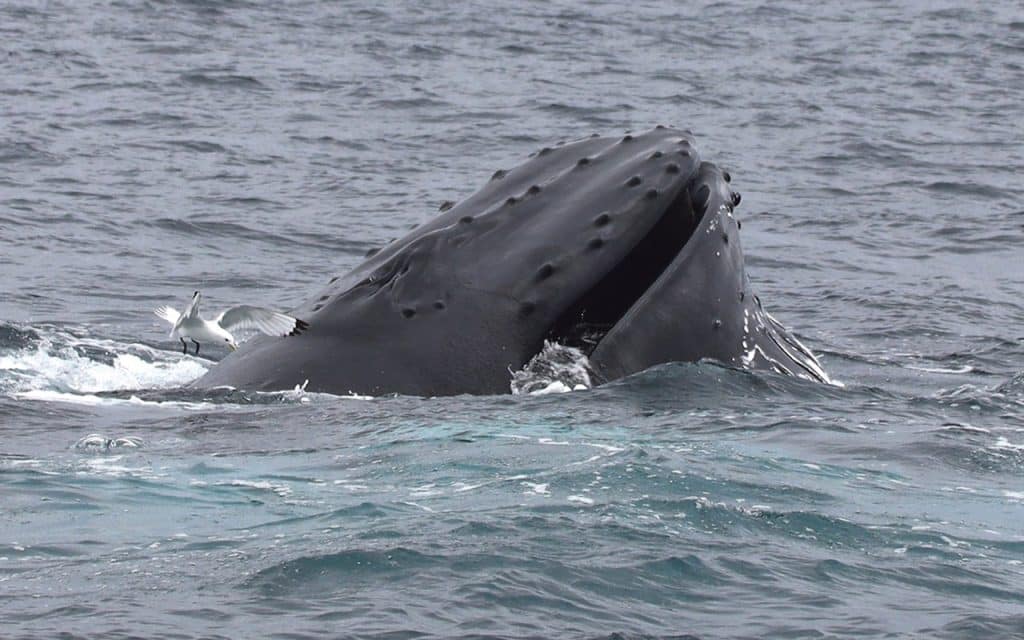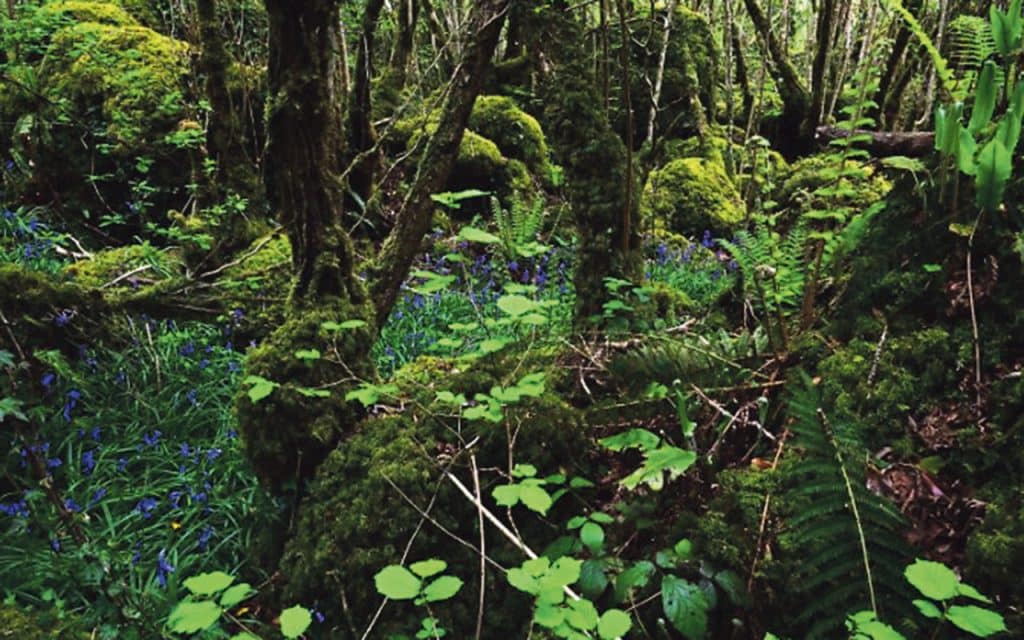
The American zoologist Roger Payne died in June this year. He was the first person to study the sounds made by humpback whales. In 1967, in Bermuda, he met an engineer working for the US navy using underwater microphones to listen for Russian submarines; sometimes other, very peculiar noises were heard. Payne identified the noises – they were made by humpbacks, and they were not just random grunts and screams, but complex songs, with repeated phrases. He released an album, ‘Songs of the Humpback Whale’, which became the most popular nature recording of all time. You must listen to it. The sounds are incredibly strange and very varied; sometimes like the rumblings of an elephant, then the ghoulish wail of a great northern diver, the creaking of an old sailing ship, a buzzing chainsaw, a screeching violin. They often seem to be cries of pain or sorrow.
The Scottish – Australian folk singer Eric Bogle (he wrote the ‘Green Fields of France’ and ‘The Band Played Waltzing Matilda’, among many others) was so moved by these whale songs, he composed his own ‘Song of the Whale’, which begins with the line: “The saddest song I have ever heard, is the song of the humpback whale.” It goes on to describe the tragedy of the whale: “… he sighs and blows as if he knows, his race is nearly run, and soon like all of his kind he’ll fall, before the whaler’s gun”.
Dr. Payne found that humpback whale songs use similar rules to human musical composition – a sonata form. These must be exceedingly intelligent, even thoughtful beings. Yet for centuries, humans – some driven by religious belief that the whale was put on earth for man to use, most too ignorant to consider the whale as anything more than a big fish – chased them, speared them, and eventually used exploding harpoons to blast their lives apart. Imagine how a whale must have felt as it was pursued by a whaling ship, and think of the grief the surviving family members suffered?
So Dr. Payne devoted the rest of his life to whale conservation, and his recording of their songs did much to make people think differently about whales. Greenpeace and its anti-whaling campaign eventually forced governments to ban commercial whaling and, thankfully, the humpback whale doesn’t have to worry about the whaler’s gun anymore. It has actually recovered well. By the time the slaughter ended in 1986, only about 5,000 humpbacks remained in the whole world; now there are thought to be 135,000. But others of his kind – minke whales particularly – are still hunted, “not for need, but for wanton greed”, as Bogle wrote, largely under the pretence of scientific research, while more, especially pilot whales and some dolphin species, are the victims of unnecessary massacres in Japan and the Faroe Islands.
The great whales do have sad expressions, unlike their permanently smiling dolphin cousins, because their mouths bend downwards – enormously so in the case of the bowhead whale – to accommodate the baleen plates used to filter plankton and small fish from the water. And I always feel sorry for them, living what, to a terrestrial creature, seems such a precarious existence. They can never really relax because they have to come to the surface to breathe (when they do sleep, half of their brain remains awake). If they get sick, they know they must move to shallow water or they might not have the strength to reach the surface. If something goes wrong, down in the dark depths of the ocean, they are doomed. There is a picture in my whale book of a sperm whale entangled in a submarine cable, over 3,000 feet below the surface. What a terrible death that animal must have had.
But until Man came along, whales had been living happily this way for more than 30 million years, ever since their four-legged ancestors moved into the sea permanently (those who doubt biological evolution might like to ponder on the back legs that many whales still possess, embedded in their blubber). And the songs the humpbacks sing are not sad. They are made by the males, singing to potential mates – the longer and more intricate the song, the fitter is the male in the eyes, or rather, ears, of the females. They are love songs.
I wrote about whales a year ago after seeing my first humpback, from the shore beside the Seven Heads. Last week, I saw another. I was most fortunate to be on a whale-watching boat, the ‘Lady Catherine’ (Atlantic Whale and Wildlife Tours), south of Courtmacsherry Bay. It was a wonderful experience, seeing the animal’s spout, the dark body and the pale shadows of its exceptionally long flippers, the dorsal fin, the arch of the back and the flukes of the great tail as it sounded. It was bubble feeding, diving below a shoal of small fish (sand-eels or sprats), blowing huge bubbles to corral them into a ball, then opening its cavernous mouth, stretching the pleats on its throat to increase capacity, before rushing upwards and swallowing the lot. All around him, kittiwakes fluttered and squawked as they picked up fish that fell from his mouth.
Even better was the fact that we knew who this whale was. It was a male called Boomerang. If you have looked at the model whale tail in Clonakilty, beside the Distillery, you should have read about him. He was first sighted off the Cork coast in 2001 and has been returning regularly ever since. We know this because he has a damaged dorsal fin, thought to be the result of an encounter with a shark or orca while he was in the breeding grounds off the Cape Verde Islands.
Ireland might now be a whale sanctuary, and Boomerang and his relations no longer have to fear the whaling ships, but many dangers remain. Noise from shipping, naval operations, undersea mining and the construction of wind turbines must all upset whales’ communications. On July 27 this year, a True’s beaked whale and its calf were stranded on a beach in Co. Mayo. They both died. This species, a rarely seen, deep-water animal, has stranded here before. But the same week, two Sowerby’s beaked whales came ashore in the Netherlands, and four bottle-nosed whales ran aground in the Orkneys. The Irish Whale and Dolphin Group fear this might be the result of some underwater human activity causing them acoustic trauma.
I wrote before of the rubbish in the sea that these whales, and other marine creatures, ingest every day, often resulting in their deaths. Just as worrying is the accumulation of toxic pollutants (industrial chemicals such as heavy metals and PCBs leaked or dumped from ships or factories) in the blubber of cetaceans, leading to all sorts of severe health problems. Then there is global warming, which will cause changes in the distribution of their prey (krill and fish), and overfishing, which will remove it completely.
Thousands of porpoises and dolphins die in fishing nets every year, even here in Ireland. But in other parts of the world, things are much worse. In the Sea of Cortez, Mexico, the smallest species of porpoise, the vaquita, is on the verge of extinction; only about ten individuals remain. They get entangled in nets used to catch totoaba, a fish that is now also endangered because of ridiculous Chinese medicine – its swim bladder is supposedly a cure for fertility problems. The totoaba only became valuable after a related fish in China was over-fished.
Another small cetacean, the Yangtze River dolphin, was declared extinct in 2006. Life in China’s longest river had become impossible for the little white dolphin, for all the same reasons its oceanic relatives are suffering: it was hunted, starved, poisoned, drowned in fishing nets, and hit and deafened by ships, until none were left.
I have been observing cetaceans since I was a boy working on my father’s angling boats in the 1970s. Nowadays, more people like to watch whales and dolphins than catch sharks, which is great. The whales we see here are mostly travellers, passing between feeding grounds in the Arctic and breeding grounds in warm waters near Africa, so sightings are irregular. But every glimpse of a whale is special, and anyone who gets to see one is always impressed by their size and strangeness. I hope whale-watchers will reflect on how terribly we have treated these mighty animals, and think about the dangers they still face. Because unless mankind changes his ways, the day will come when the whale’s song really will be sad, as the last one will be singing to himself.



